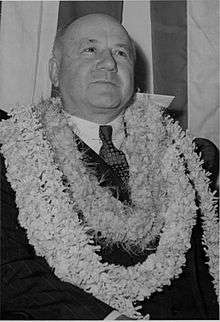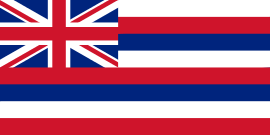Ingram Stainback
| Ingram Stainback | |
|---|---|
 | |
| 9th Territorial Governor of Hawaii | |
|
In office August 24, 1942 – May 8, 1951 | |
| Appointed by | Franklin D. Roosevelt |
| Preceded by | Joseph Poindexter |
| Succeeded by | Oren E. Long |
| Personal details | |
| Born |
Ingram Macklin Stainback May 12, 1883 Somerville, Tennessee |
| Died |
April 12, 1961 (aged 77) Honolulu, Hawaiʻi |
| Alma mater |
Princeton University University of Chicago |
Ingram Macklin Stainback (May 12, 1883 – April 12, 1961) was the ninth Territorial Governor of Hawaii and served from 1942 to 1951.
Born in 1883 in Somerville, Tennessee, he received his undergraduate degree from Princeton University and his Juris Doctor from the University of Chicago.
Stainback, a well-connected Democrat, came to Hawaii shortly after graduation and was appointed by Democratic Governor Lucius E. Pinkham in 1914 to the post of Territorial Attorney General.[1] He resigned in 1917 to join the Army and rose to the rank of major. When the war ended he returned to private practice in Hawaii.
Previous to his administration, Stainback was a United States District Attorney and then a judge on the U.S. District Court for the Territory of Hawaii. He was appointed to the office by President Franklin D. Roosevelt. It is likely that his friendships with then-Secretary of State Cordell Hull and Senator Kenneth McKellar, both Tennesseans, played a role in his appointment. However, Stainback was essentially powerless for the first two years of his term since Gov. Joseph B. Poindexter had allowed the military to take over the government on December 7, 1941. During that time, Hawaii was governed by Army generals Walter Short, Delos Emmons, and Robert C. Richardson, Jr.
A conservative Democrat, Stainback, whose full powers were restored on April 13, 1944, played a significant role in the lifting of martial law in wartime Hawaii. Stainback believed Communists were plotting to take over the Hawaiian Islands. He also provided a genesis for Hawaii's Democratic Revolution of 1954 by decrying the land monopolies in Hawaii and calling for land reform. Upon resigning his post on May 8, 1951, Stainback had served eight years, eight months and six days, the longest of any appointed governor up to that point.[2]
On September 26, 1951, he was appointed by President Harry S. Truman as an associate judge to the Hawaii Supreme Court. Stainback argued for Commonwealth status similar to Puerto Rico instead of statehood, arguing that Hawaii would benefit from the federal tax exemption. He died in 1961 in Honolulu, Hawaiʻi and is buried at Oahu Cemetery.
He is memorialized on the island of Hawaii by the Stainback Highway, a little-used 18-mile road that leads from the Hawaii Belt Road near Hilo at 19°39′49″N 155°3′40″W / 19.66361°N 155.06111°W to Kulani Correctional Facility, a medium security state prison at 19°33′0″N 155°18′4″W / 19.55000°N 155.30111°W.[3] His son, Macklin Fleming, was an Associate Justice of the California Court of Appeal and an early opponent of affirmative action.[4][5]
References
- ↑ "Stainback, Ingram Macklin office record". state archives digital collections. state of Hawaii. Retrieved 2009-11-19.
- ↑ "Past Governors". State of Hawaii office of the Governor. Retrieved 2009-11-19.
- ↑ "Kulani Correctional Facility". Hawaii state department of public safety. Retrieved 2009-11-19.
- ↑ "The black quota at Yale Law School" (PDF). The Public Interest. 1969.
- ↑ http://www.courts.ca.gov/documents/Fleming_Macklin_Biography.pdf
External links
| Wikimedia Commons has media related to Ingram Stainback. |
Ingram Stainback at Find a Grave
| Political offices | ||
|---|---|---|
| Preceded by Joseph Poindexter |
Territorial Governor of Hawaii 1942–1951 |
Succeeded by Oren E. Long |


